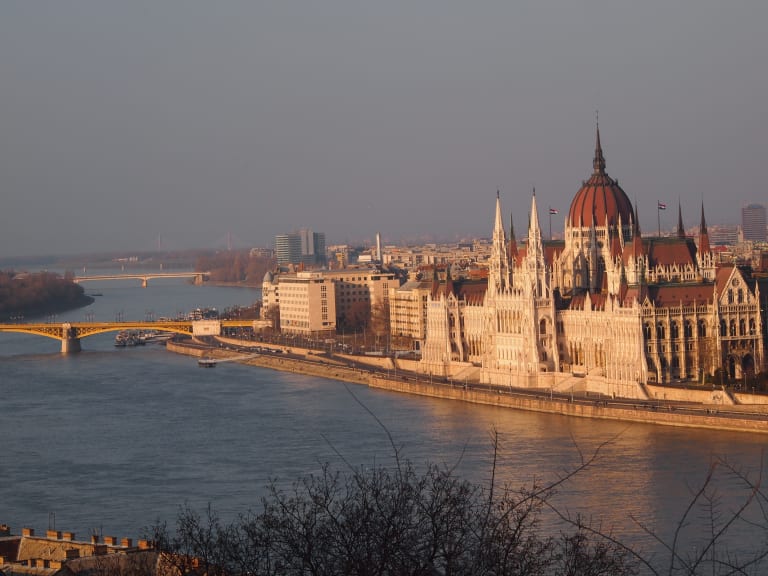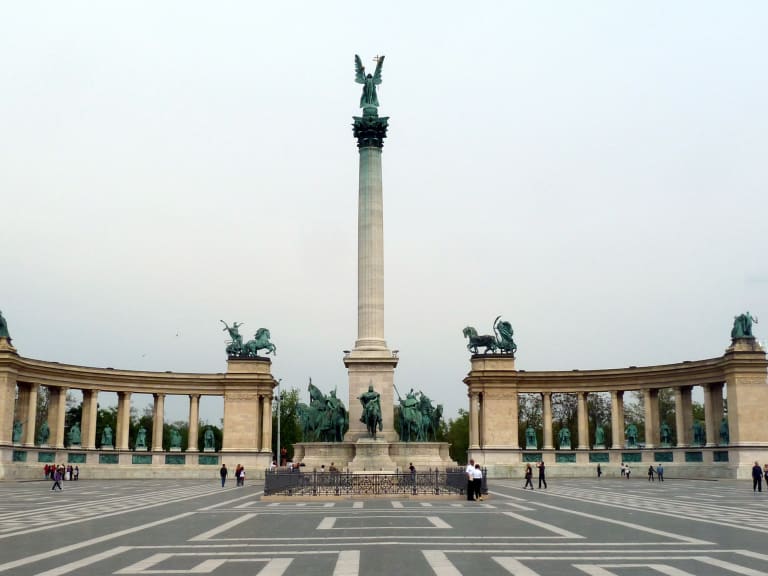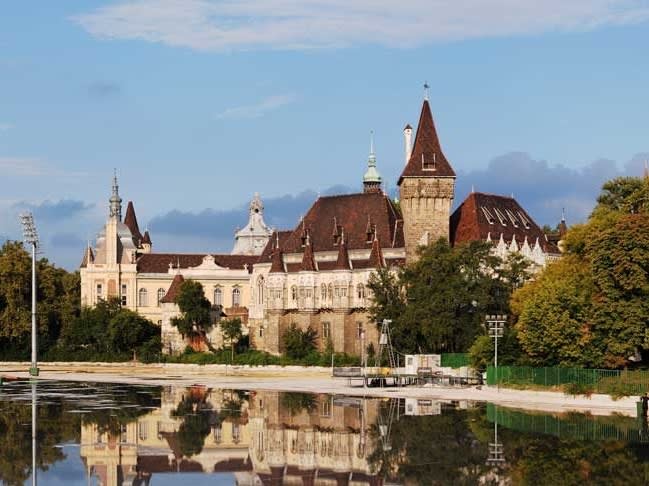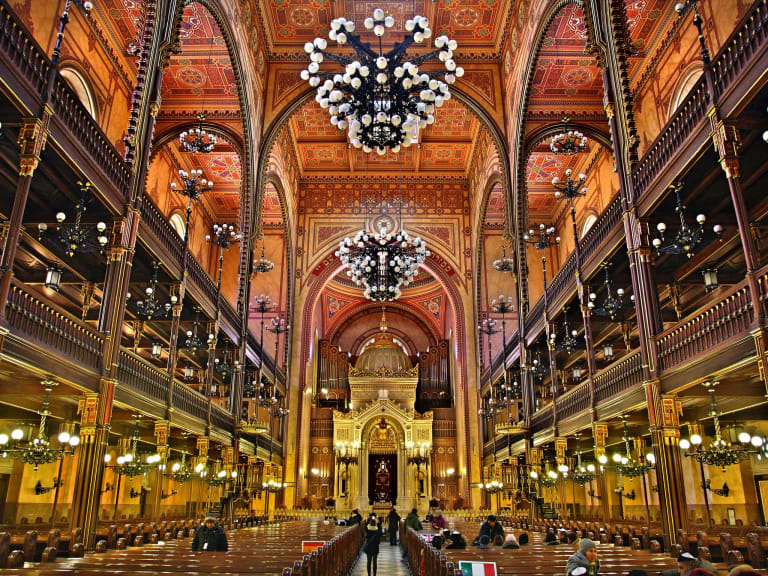More about: Budapest in 5 Days: tips, what to see, and much more
There is no doubt that there are many things to see and do in Budapest, but those who have 5 days to visit will not miss any of them. During your stay you will be able to see its palaces, churches, ruins bar, the attractions hidden in the Jewish quarter and even take a short cruise on the Danube and spend a few hours in a spa.
Budapest offers its visitors history and beauty in equal parts. In this tour I have prepared you have all the information you need to enjoy this fantastic city.
Day 1: Explore Pest and visit the Parliament

The first day in Budapest will be dedicated to one of the two main areas in which the city is divided: Pest. If you prefer, you can book a guided tour of Budapest to make your first tour, as the city offers these routes both walking and cycling itineraries in Budapest.
These first hours in the city will not only serve you to see some monuments and essential streets, but also to know how you can move around Budapest, what kind of restaurants there are or the existing price level.
Marvel with the Parliament building
One of the essential visits of Budapest is the fabulous building in which the Parliament is located. Built between 1884 and 1902, at the time it was the largest building in the world. It has 691 rooms, some of which can be known, but only with guided tours of Parliament.
This guided tour will take you about an hour, to which you must add the time it takes before entering to comply with all security measures and form groups. Its main attractions are the following:
- Main staircase: it will be the first impression you are going to have of the Parliament and I assure you that you will not be disappointed.
- Dome Hall: it is located inside the dome and in it are placed several statues of the kings of the country. The most popular is that of St. Stephen, whose crown can also be seen in the same room.
- Former Upper House: although today it is not used for political activity, its structure is still that of a parliamentary chamber.
Climb the tower of St. Stephen's Basilica
When you finish your visit to the Parliament, I recommend that you take a leisurely stroll through the streets of Pest in the direction of St. Stephen's Basilica, easily recognizable by its high towers.
This church is the largest temple in the country and is estimated to hold about 8,500 people. Admission is free, although you will have to pay a small fee to see the Treasury and the Dome. In addition to seeing its interior decoration, as well as the mummified hand of St. Stephen in the chapel, it is essential that you go up one of the towers (by elevator) to have a great view of the city.
And, of course, you can also make the most of your visit and see an organ concert at St. Stephen's Basilica in Budapest.
Take a leisurely stroll along Andrassy Avenue

The next point of interest of the itinerary is the Andrassy Avenue. It is lined with impressive Renaissance buildings and palaces, something that earned it to be named a World Heritage Site by Unesco in 2002.
Two of the places you can not miss during this walk are the Deschler Palace and the Opera House. The latter can be visited with a guide if you are interested.
Grab a bite to eat at Frici Papa, a city classic
Although you are going to have to take a little detour (nothing serious since the area is really striking) I recommend you to have your first meal at Frici Papa, located at Kiraly utca 55.
Although it is usually full of tourists, the prices are really reasonable, with a menu of the day for just 5 €. The half liter beer will cost you about 1,5 €.
Joaquin's Traveller Tip
I recommend you to be careful with ordering too much, as the portions in Budapest are really generous.
Stroll to Elisabeth Ter Park
Along the same Kiraly Utca you go down towards the river contemplating some interesting churches (as well as a Hindu temple) of this street full of stores and restaurants.
In the Elisabeth Ter Park there is a Ferris wheel with stunning views of the city, plus the Metro museum and a curious corner dedicated to the memory of Michael Jackson.
When you have finished seeing the park you can go to the nearby Vorosmarty Ter, one of the most important squares of the city. If you feel like it, there you can enter the Gerbeaud's pastry shop to try one of their famous ice creams.
Take a ride along the banks of the Danube

Almost at the end of the day, a good idea may be to go to the Danube bank and walk along it calmly and enjoying the wonderful views of the Buda Castle that you can see from there.
During this walk you will pass next to the famous Chain Bridge, where you can look out to see the Danube crossing. If you go in winter to Budapest, as happened to me on one occasion, you may encounter the fabulous image of a river full of ice blocks crashing against the pillars of the bridge.
Meditate in front of the Shoe Monument
Before retiring for lunch, the tour will take you to one of the most powerful monuments in the city. At first glance, it is just small statues representing shoes placed by the river. However, if you know the history it intends to pay tribute to, there is no doubt that the feeling will change.
This monument was erected in memory of the many Jews killed during the Second World War. The Nazi way of proceeding was to tie up the Jews in the ghetto in pairs and shoot one before throwing them into the river. The shoes, therefore, are a memorial to those executed in cold blood.
Dinner at the Hungarikum Bisztro to end the day
After a busy day, there's nothing better than a leisurely dinner at one of the city's best-known restaurants: the Hungarikum Bisztro.
Just 500 meters from the Parliament, this place offers quality traditional food in a great atmosphere.
Day 2: Discover the Buda district, from the castle to the labyrinth.

The other major part of the city, Buda, offers a wealth of attractions for any visitor. Although the highlight is the castle, the surrounding neighborhood is worth spending several hours contemplating its beautiful historic houses and churches.
If you prefer to be accompanied by a guide you can choose from several tours to the Buda Castle and its neighborhood. This option has the advantage of knowing the history of each of the interesting places in the area and, in addition, you can always extend the visit later to not leave anything unseen to your liking.
Start the day in Szent Gellért
Crossing the Liberty Bridge (the one next to the Central Market) you will be able to see the Szent Gellért spa. Besides walking, you can also get here by subway, as there is a stop right next to it with the same name.
Although it is worth seeing the facade of the spa, this time it will only serve as a reference to start the tour.
Be amazed by the Rupestrian Church
A good part of the Gellért mountain, very close to the spa, is perforated by a series of tunnels product of the action of the thermal waters that crossed its interior.
This erosion caused the creation of several rooms, among which stands out the one that was converted into the so-called Rupestrian church. In it you can see a painting of St. Kolbe, a Polish monk who tried to save several prisoners of the Auschwitz concentration camp. In addition, you can also see a reproduction of the Black Madonna of Czestochowa (Poland).
The entrance to this church is completely free and can be accessed from Monday to Saturday between 9:30 am and 7:30 pm.
Visit the Buda Castle

From the Rupestrian church you have to walk along the bank of the Danube for a few minutes before starting to climb up to the castle. Along the way you will be able to see the monument to Szent Gellért (St. Gerard), a bronze statue located where it is said he suffered his martyrdom.
To climb the hill on which the Buda Castle is located you can choose between taking a funicular or go up the slopes that lead to that area.
The Buda Castle, also called Royal Palace for having been the residence of the Hungarian kings, consists of a large central courtyard, several remnants of the wall, a beautiful neo-Gothic fountain, gardens and a large building divided into three wings. These house the Széchenyi Library, the Hungarian National Gallery and the Budapest History Museum. Entering the complex is free, but visits to the museums are paid. They are usually open between 10 a.m. and 6 p.m., with the exception of Mondays, when they are closed.
Don't miss the Fishermen's Bastion
After seeing the castle in depth (entering or not in the museums depending on your interests), it's time to approach one of the most impressive places in Budapest: the Fishermen's Bastion.
The Bastion dates from 1905 and received its name because it is located in the part of the walls whose defense was entrusted to the fishermen in the Middle Ages. From here you can see possibly the best panoramic view of the whole city, with the Danube at his feet, the Chain Bridge to the right and the Parliament in the background.
The seven towers of which the monument consists represent the chiefs of the Magyar tribes. If you enter the walled enclosure you will find a palace, a castle and the sensational Matthias Church.
If you feel like it, in this area there are several restaurants where you can eat something. I warn you that they are usually a bit expensive, but you will also find some fast food chains nearby that can be useful for this occasion.
Joaquin's Traveller Tip
I advise you to try to see the Bastion illuminated at night, as it acquires a reddish color of great beauty.
Enter the Matthias Church

The Matthias Church is another must-see when you are in the Buda area. Actually, its name is Our Lady's Church, but it is better known by the name of the Hungarian King Matthias, one of the country's heroes.
Many royal weddings were held inside, as well as several coronations. The latter explains why there is a copy of the crown there.
The entrance to the church is paid, but there are two different types of entrance. One, the simplest (about 5 €) is for entering the temple itself, while the other (with the same price) is necessary to climb the tower.
Try not to get lost in the Buda Labyrinth
The Buda district still has other charms to show. If you walk through its streets you will reach the Buda Labyrinth, a series of grottoes that have been conditioned for your visit, although only just over 1 kilometer of the total 7 kilometers that are estimated to exist.
Once inside the labyrinth you will be able to see a number of things: fountains, columns, cave paintings, statues, etc..
If you have the chance, try to visit this place after 18:00. At that time the lights are usually turned off completely and the visit is done with oil lamps.
Joaquin's Traveller Tip
If you like the depths and history, not too far away is a former subway hospital that was converted into a nuclear bunker at the end of World War II and during the Cold War. A truly impressive visit.
Walk to the river and photo in front of the Parliament
The last walk of the day should take you through the streets of the neighborhood to the river. Although you will have to walk a bit more to cross one of the bridges, I advise you to walk until you are right in front of the Parliament.
The view of this building, especially at night with the lighting, on the other side of the Danube is one of the best pictures you can take.
After this, you just have to go back to your hotel and look for a place to have dinner and relax after a tiring day.
Day 3: a more relaxed tour with a grand finale

For the third day in Budapest I have prepared a much more relaxed tour so you can recover your strength after the first two days.
A large park and a final surprise are the highlights of the day. Of course, do not forget to take a swimsuit before leaving the hotel.
Contemplate the monuments of the Heroes' Square
To start the day you have to return to Andrassy Avenue, but with the intention of walking to the north. A good way to get there is by subway, since the line that passes under this avenue is the second oldest in the world and is worth knowing. Already in Andrassy you have to walk in the opposite direction to the river, an area with fewer historic buildings, but with many embassies. At the end of the street is the Heroes' Square, one of the most important in the city.
In the square you will be able to see the impressive Millennium Monument. It depicts the seven Magyar tribes that founded the country. Do not miss two neoclassical buildings located in the same square: the Palace of Art and the Museum of Fine Arts in Budapest. My advice, moreover, is to enter the latter and spend some time in it.
Inside you can see works by renowned painters such as El Greco, Picasso, Raphael and Cézanne. It also highlights its classical art rooms, with various objects from Greece, Rome and Egypt, including some mummies. The entrance fee is less than 9 € and if you have the Budapest Card you will get a 10% discount.
Lose yourself in the City Park
Behind the square is the City Park, whose beauty is enhanced by the castle inside.
Originally, this park was conceived as a hunting ground for the nobility, but from the eighteenth century it was transformed into what it is today: one of the meeting points for the inhabitants of the city when they want to walk with the family.
Its large dimensions, 1,400 by 900 meters, make this green area one of the recreation areas of the city. Inside there is a lake where you can rent a boat or go ice skating, depending on the time of year you have traveled.
Take some time to visit the small Vajdahunyad Castle and its church

Still within the park is the Vajdahunyad Castle, a building constructed on the occasion of the 1896 Expo. At that time, the castle was built with wood, the same design was repeated in stone, which is how it can be seen today. To do so, some parts were copied from other existing buildings in various parts of Hungary, although the whole is quite homogeneous. If you can, climb one of the towers to have a view of the whole area.
On the other hand, inside the castle you can visit a museum dedicated to agriculture, as well as a very small but really beautiful church.
When you have finished touring the castle and visiting its attractions, I advise you to buy some food in one of the kiosks that are usually in the area and sit on a bench in the park to eat quietly before continuing.
Relax at the Széchenyi Spa
The big surprise inside the City Park is undoubtedly the presence of one of the best spas in Budapest: the Széchenyi Spa. My proposal is that you enter and relax at ease in what is one of the great attractions of the city.
In this spa you will be able to stay as long as you want. With its 18 pools, both indoor and outdoor, this is the largest establishment of its kind in the city. All these pools are filled with spring water and the place also has several steam rooms and saunas located under baroque style domes.
End the day with a dinner cruise on the Danube
To end the day, after spending a few hours at the spa, there is no better plan than heading to the river for a dinner cruise.
From the boat you will be able to admire the main monuments of the city from a different point of view. In addition, while live music plays, you can enjoy a fabulous dinner accompanied by local wine.
Day 4: Excursion to Balaton Lake

One of the advantages of having so many days to visit Budapest is that you have the option to make some interesting excursions in the surroundings. Although you can choose between several (like going to the Gödöllo Palace, to the Lake Balaton and Herend or going to Vienna from Budapest), in this occasion I propose you to go to one of the most visited places of the country: the Lake Balaton.
Lake Balaton
Many consider this lake as a real inland sea in Hungary. Located about 100 kilometers from the capital, it is the largest freshwater lake in Central Europe.
On this day trip you will have the opportunity to comfortably explore the surroundings of the lake, on the shores of which there are several towns with a rich cultural and leisure heritage.
Tihany Abbey
One of the most interesting stops on this excursion is the Tihany Abbey, located in the village of the same name. Founded as a Benedictine monastery in 1055, a visit to its interior is highly recommended.
The village of Tihany itself also deserves some time to stroll through its streets, although it cannot compare with the sensational views of Lake Balaton and the natural environment surrounding the abbey.
The spa town of Balatonfüred
No excursion to the lake would be complete without a stop in Balatonfüred, the oldest spa town in Hungary. In its streets you will be able to see how the most modern buildings coexist with ancient palaces where the aristocracy of the Austro-Hungarian Empire spent their vacations.
The city is also well known for its hot springs and for its beautiful promenade along the lake shore.
Day 5: From the Jewish Quarter to the Ruins Bar

I recommend that in your list of what to see and do in Budapest you leave for the morning of the last day of your trip to visit the Jewish Quarter of Budapest. As in other parts of Central and Eastern Europe, during the Second World War its streets were converted into a ghetto and a real concentration camp.
If you want to make this tour in a more comfortable way, you can always hire some of the guided tours through the Jewish quarter. The best thing about this option is to have a guide who will explain the history of the area and the Hebrew community that lived here.
Jewish Synagogue
The most interesting place in the neighborhood is the Jewish Synagogue, the second largest temple of this confession in the world after the one in Jerusalem. The building was constructed between 1854 and 1859, in a Moorish style with Byzantine, Romantic and Gothic influences.
The interior is really impressive, with some not very traditional elements of Hebrew architecture such as an organ or the Moorish dome. Very interesting are also the large cast iron columns located in the women's area.
Next to the synagogue is the Jewish Museum, very suitable for those who want to delve into the history of Judaism in the country.
Outside the Synagogue: the Temple of Heroes and the Jewish Cemetery
Also next to the synagogue you will be able to see some elements without which the history of the Jewish community in Budapest would not be understood. One of them is the Temple of Heroes, dedicated to the Jews who died in the First World War. Another is the Jewish Cemetery, which is worth a visit even though it is not as impressive as the one in Prague.
In that part of the neighborhood you should also look for the so-called Tree of Life. It is a sculpture representing a weeping willow tree erected in 1991. On each leaf is written the name of one of the Jewish victims of the neighborhood during the Holocaust.
Visit the post the best tours of the Jewish quarter of Budapest and discover everything you need to know about this area of the Hungarian capital.
Take a leisurely walk through Váci Utca

After visiting the Jewish quarter it is time to visit the second most important street of the city center after Andrassy Avenue: Váci Utca. This is parallel to the Danube and runs from Vörösmarty Square to the Great Central Market.
This street was built in the eighteenth century and still retains some mansions of that time. However, almost all the buildings that can be seen today date from two centuries later.
In its first decades, the street was a meeting place for the city's upper classes, but today it has been filled with souvenir stores, restaurants, cafés and shopping malls. This, however, has not caused it to lose its charm and it is worth a leisurely stroll. Although you can try to eat something here, my advice is to wait a bit until you get to the Central Market.
Budapest Central Market: the gastronomic cathedral of the city
It is hard to believe that when the Central Market was built at the end of the 19th century, it provoked protests from many citizens who claimed that prices had risen because of it. It is also hard to believe that this great gastronomic temple was practically unused for decades after World War II, when it was severely damaged.
Today, after being restored between 1991 and 1994, this great building is one of the most visited in the city. In its stalls you will be able to find all the ingredients of Hungarian cuisine, as well as souvenir stores and other items.
On the second floor there are a number of small food shops where I recommend having lunch. Note that many of them retain the custom of sharing a table with other diners, but this adds to the authenticity of the experience.
Do your last shopping and stroll around
For the rest of the afternoon I recommend that you relax by strolling through the streets of the center. Either in Váci Utca, in the Central Market or in the nearby streets you can do your last shopping and stop at one of the wonderful cafes in the area whenever you feel like it.
You can also stroll along the river bank and get to the Chain Bridge to say goodbye until the next visit.
Ruin Bars Route
You can not leave the Hungarian capital without knowing its famous ruin bars, the best places to enjoy the night of Budapest.
These locals (whose name means ruin bars) emerged after the fall of the Iron Curtain when groups of young people began to condition abandoned buildings to convert them into entertainment bars. Many of them are located in the Jewish quarter, today one of the most revitalized of the city.
If it is the first time you are in the city I recommend you to hire one of the tours that visit several ruin bars and in which some drinks are included. Those who prefer to go on their own can read about the best ones in this article.




